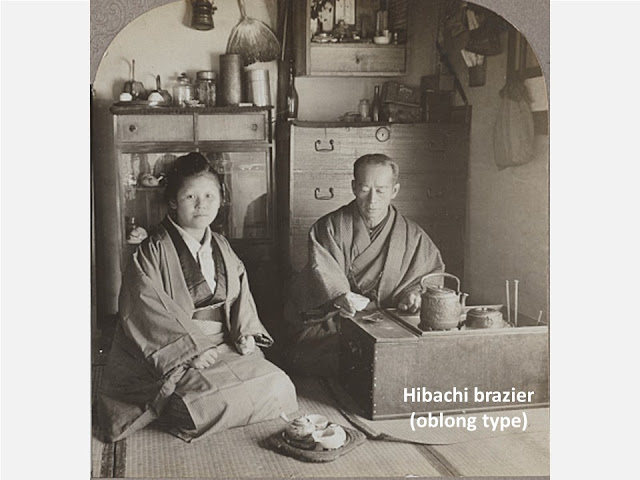Fun during nomadic life、流離(さすら)いの中の楽しみ
・Knowledgeable person、世間師(一)
Surprisingly, there were young
wanderers even in the pre-modern era. They were versed in the ways of the world
and were called “Seken (society)-shi (instructor)” or a knowledgeable person.
They sometimes taught and advised villagers who spent most of their time in
their village.
Masuda Itarou, who was the
neighbor of the author and was born in 1852, went to Ehime Prefecture in
Shikoku Island to work as a sawyer. They worked in a mountain and talked
various stories at night, which included strange storied such as about Tengu
(monster), wolves, raccoon dogs and so on. There were no TV so they just
talked, and they widened their knowledge.
Itarou became a carpenter and started
wandering. He went to Kumamoto
in Kyushu Island and joined the reconstruction work after the internal war at
the beginning of the Meiji period (1868-1912). It is called Satsuma Rebellion
(1877); samurais rebelled against the new government which didn’t hire them.
In Kumamoto, he visited a women’s room
secretly at night, which was a common custom across Japan back then. He also
stole chickens which Kumamoto people didn’t eat and made a hot pot.
Furthermore, he got married even though he had a wife in his home village. He
was finally brought back to his village two years later. There are men like him
even until now.
He went to Kagoshima in Kyushu Island as a carpenter. He
earned a reputation as a skilled man, so he got a job in Tokyo; he built
houses for commissioned officers from Kagoshima. Yamamoto Gonnohyoe’s house was
included, who became a prime minister later. However, he didn’t like his
customers, because he had to bow them always. Finally, he left Tokyo and went
to Gifu Prefecture to join the reconstruction work after the big earthquake in
1891.
In Gifu, people welcomed carpenters, and he
didn’t have to flatter customers. He was invited for a meal and a drink. He was
good at singing, was a good performer and versed in the world; it means he
could entertain attendees. Happily, he drank almost every day. Moreover, he got
a girlfriend. He had no complaint! I’m sure we are happy when we have a job and
a leeway for drinking.
The reconstruction work in Gifu was
completed in a few years. He returned to his village and went to Yamaguchi,
which is a prefectural capital where his village is. He went there with his
wife because of her request.
Then, he moved to Taiwan alone, which
became a Japanese territory after the First Sino-Japanese War. The ship to
Taiwan was full of Japanese who wanted to succeed there. Surprisingly enough, the
fare of entertainers was generally free at that time; they played
performances instead of the payment. Plus, the accommodation fee (without
meals) was also free. Therefore, there were actually many traveling
entertainers. Art brings bread; they didn’t have to worry about eating,
too. Due to their singing, dancing and magic tricks, he arrived at Taiwan in no
time. Btw, Amino Yoshihiko, who was a famous medieval historian, commented that
it might be a relic of an ancient practice; entertainers kept perks to go
anywhere by any ship and to be allowed exemptions from toll tax when they
served to gods in the ancient era. They were originally treated kindly and were
welcome in everywhere.
In Taiwan, there were plenty of construction
works such as building the Office of the
Governor-General Taiwan. He was a master carpenter and did good work, so a
task request continued seamlessly. His sole problem was to find a girlfriend.
It was difficult for him to understand how local women felt. On the other hand,
he was reluctant to date Japanese women who were like prostitutes. He said,
“Farmer’s daughters were great. More than anything, they perfectly took
personal care of me after being in love. I tended to behave like a married
couple.”
Afterward, he went to Seoul, worked
for just over a year and returned. Then, he worked in Osaka, Kita-Kyushu
and so on. He probably continued enjoying local life in various places.
His turning point was his son’s death
in battle (the
Russo‐Japanese War., 1904-1905). He quit wandering and stayed at home. He
always smoked pipe tobacco in front of a hibachi brazier. When someone
visited, he went on talking about his past; he had abundant topics. Thereafter,
he kept his lifestyle around thirty years and passed away over eighty.
https://www.loc.gov/item/2020634665/
日本の村々には意外なほど若いときに奔放な旅をしたものが多くて、村人たちは世間師だといっていました。村の外をこと、世間を知る人たちです。何かにつけて、村人に情報を与え、アドバイスをしたようです。
著者の隣家の主人・増田伊太郎(1852年生)さんは、伊予で木挽の出稼ぎをしていました。山仕事では、夜の小屋で、天狗、狼、狸などの話が語られました。TVの代わりに語り合って時間を過ごしたのですね。よその土地で仕事をすると見聞も広がります。
伊太郎さんは大工になり、西南戦争で焼けた熊本の復興工事に行きました。若い大工仲間は夜這いをし、熊本の人が食べない鶏を盗んで肉鍋にして食べました。伊太郎は妻がいるのに、熊本で入り婿になり戻らず、二年間後には連れ帰されました。こんな人は今もいるかもしれません。
鹿児島に大工仕事に行った伊太郎さんは、腕の良い長州大工の一人として東京で薩摩の海軍士官などの家を建てました。海軍出身で後に首相になった山本権兵衛(1852〜1933)の家も建て、見かけることもありました。しかし、ヘイコラと頭を下げねばならず面白くなかったのです。東京を離れ、明治24年に大地震があった美濃へ行きました。
美濃では大工は大切にされました。手に職があるのでヘイコラする必要もありません。その上、酒盛りがあると招かれました。彼は、歌が上手で芸が達者、よく世間を知っているから座持ちが良かったのです。毎晩ほど飲みました。心やすい娘もできたし、何一つ不自由はありませんでした。仕事して飲んでいれば、それで十分幸せですね。
美濃の仕事は一、二年で片付き、郷里へ戻った後、妻を同行して山口で仕事をしました。同行は妻の希望でした。
参考文献〔1〕網野善彦(2003):『忘れられた日本人』を読む
さて、台湾では総督府の建設など仕事がいくらでもあり、棟梁となった伊太郎は、良い仕事をして、仕事がなくなることはありませんでした。でも、女がいないのには困りました。台湾の人は様子が分らず、日本から来た「あばずれの淫売女」には手を出す気がしませんでした。「よいのはやっぱり百姓の娘で、心やすくなると何から何まで身の回りの事までしてくれるのが一ばんありがたかったし、つい夫婦気どりになってしまうのである」と書かれています。
それで台湾を引き上げ、京城(現ソウル)に行きましたが一年余りで引き揚げ、大阪や北九州で仕事をしました。ヘイコラいうこともなく、こんな暮らしをしていると抜けられませんね。
彼の転機は長男の戦死(日露戦争)でした。以降、ぷっつりと旅を止め、火鉢の前に座って、一日中きざみ煙草をキセルで吸っていました。そして、人が来てくれれば、過ぎ去った日を尽きることなく話し続けました。その生活を30年間くずさず、八十過ぎでなくなりました。
Previous post (Part2 of this article, Entertainments、芸能・余興の楽しみ): The Forgotten Japanese (published in 1960 )(2/6)、忘れられた日本人 part2
Next post (Part4 of this article, Fun of nomadic life(2)、さすらいの中の楽しみ(2)): The Forgotten Japanese (published in 1960 )(4/6)、忘れられた日本人 part4




Comments
Post a Comment